![]() 1st Battalion 22nd Infantry
1st Battalion 22nd Infantry ![]()
Captain J.B. Irvine 22nd Infantry 1866-1891
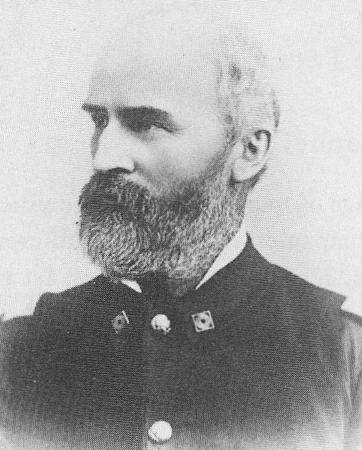
This photo of J. B. Irvine was taken
while he was a Captain in the 22nd
Infantry.
The marksman buttons on the collar of his uniform indicate the
photo was taken between the years 1881 and 1891.
Photo from the South
Dakota magazine.com website
Javan Bradley Irvine was born in
Dansville, Livingston County, New York on April 3, 1831.
He settled in Minnesota in 1852. Around 1858 he became a Private
in a local militia unit called the Pioneer Guard.
When the Civil War started in 1861, the Pioneer Guard became the
1st Minnesota Volunteer Infantry Regiment.
Irvine was 30 years old at the
time. For his gallant conduct during the first Battle of Bull
Run, and for capturing
a Confederate Lieutenant Colonel during the fight, he was
recommended for a commission in the Regular Army
by several notable people, including a couple of senators from
Minnesota.
Irvine is recorded as having
enlisted in Company A, Minnesota 1st Infantry Regiment on April
29, 1861
and mustered out on December 15, 1861 in order to take a
commission as an officer in the Regular Army.
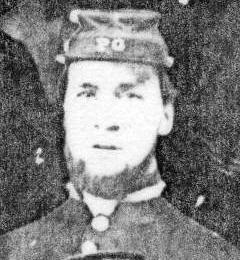
Photo of Javan B. Irvine
taken as a member of the Pioneer Guard 1858.
Note the lertters on his cap of "PG" for Pioneer Guard.
Photo from the Minnesota Historical Society via the 1st Minnesota Volunteer Infantry website
In Irvine's letters home to his wife he described his part in the first Battle of Bull Run:
Javan B. Irvine,
of St. Paul, arrived a few days before the battle on a visit to
his brother-in-law, Mr. Halsted, of Company A.
In civilian's dress, he took a musket and went into action, and
captured the officer of the highest rank among all the prisoners
taken by the various brigades. For his bravery, he was made First
Lieutenant 13th United States Infantry on October twenty-sixth,
1861. He is still a captain in the regular army. Mr. Irvine's
letters to his wife, published -in one of the St. Paul papers,
were among
the best written after the fight, and are worthy of preservation.
He says:
" We took a
circuitous route through the woods, and arrived in vicinity of
the enemy at about ten o'clock in the morning.
While on the march, the battle was commenced by the artillery who
were in the advance, and the roar of which we could
distinctly hear some three or four miles off, and the smoke
rising at every discharge of the same.
" You can
form some idea, perhaps, of our forces, when I tell you that our
lines were some five or six miles in length,
and the Minnesota Regiment was as difficult to find as it would
be to find a single person in a very large crowd of men.
At about eleven
o'clock we halted in a ravine, to give the men an opportunity to
fill their canteens with water. At this time
the firing had become pretty general, and the roar of artillery
and the rattle of musketry was beard only about a mile distant.
You have, no doubt, read of the agitation and fear which come
over individuals on the approach of battle, but I must say,
and I say it not in the spirit of braggadocio either, that I
experienced no such fears or agitation during the conflict.
I was surprised at this myself, for I certainly thought that I
should feel as writers have so often described.
We soon came to
a road where we were met by an aid to the commanding officer, who
desired us to follow him and take up
a position where he could get no other troops to stand. We told
him we would follow him, and he gave us a position to the
left of the battery and directly opposite to it. Here we formed
in line of battle, with a strip of woods between us and about
four thousand secessionists. We had just formed when we were
ordered to kneel and fire upon the rebels, who were advancing
under cover of the woods. We fired two volleys through the woods,
when we were ordered to rally in the woods in our rear,
which all did except the first platoon of our own company, who
did not hear the order and stood their ground.
The rebels soon
came out from their shelter between us and their battery. Colonel
Gorman mistook them for friends and told
the men to cease firing upon them, although they had three
secession flags flying directly in front of their advancing
columns.
This threw our men into confusion, some declaring they were
friends, others that they were enemies. I called to our boys to
give it to them, and fired away myself as rapidly as possible.
The rebels themselves mistook us for Georgia troops, and waved
their hands at us to cease firing. I had just loaded to give them
another charge when a lieutenant-colonel of a Mississippi
regiment
rode out between us, waving his hand for us to stop firing. I
rushed up to him and asked if he was a secessionist.
He said 'he was
a Mississippian.' I presented my bayonet to his breast and
commanded him to surrender, which he did
after some hesitation. I ordered him to dismount, and led him and
his horse from the field, in the meantime disarming him
of his sword and pistols. I led him off about two miles and
placed him in charge of a lieutenant, with an escort of cavalry,
to be taken to General McDowell. He requested the officer to
allow me to accompany him, as he desired my protection.
The officers assured him that he would be safe in their hands,
and he rode off. I retained his pistol, but sent his sword with
him." ¹
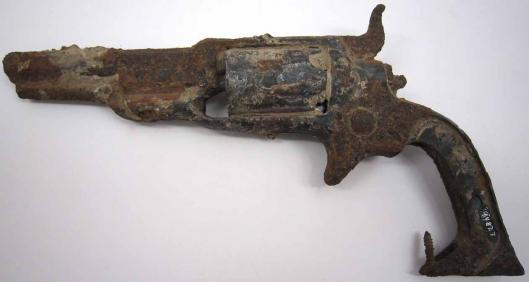
Captured Colt Model 1855
“Root” sidehammer revolver. This .28 caliber, five-shot
revolver was captured by Javan B. Irvine
of the 1st Minnesota Volunteer Infantry Regiment, Company A,
during the the First Battle of Bull Run.
At Bull Run, the 1st Minnesota had not yet been issued regular
army uniforms and most of the men were wearing red flannel
shirts, similar to the style worn
by the 4th Alabama. The uniform similarities caused confusion
among the troops and allowed Private Irvine to force Confederate
Lieutenant Colonel
Bartley B. Boone of the 2nd Mississippi to surrender. Boone was
the highest ranking Confederate officer captured at the First
Bull Run.
At gunpoint, Irvine forced Boone to dismount, disarmed him, and
turned Boone over to a Union lieutenant to be taken to General
Irvin McDowell.
While Irvine sent Boone’s sword with him, Irvine kept the
revolver for himself. (Fire damage to the revolver occurred
later, burning away the revolver’s grips.)
Minnesota Historical Society
On October 26, 1861, Irvine was
offered a commission as a 1st Lieutenant in the 13th U.S.
Infantry, a position which he accepted
on December 2, 1961. He continued with that unit during the War,
serving for a time as adjutant at the military prison
at Alton, Illinois, and was Regimental Quartermaster of the 13th
Infantry from November 1, 1862 to March 1, 1865.
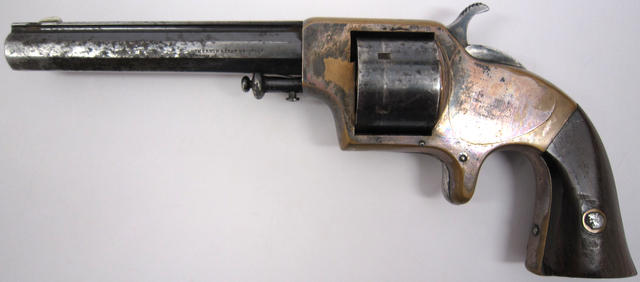
Third Model "Army" .42
caliber six-shot front loading revolver made by Plant's
Manufacturing Company in New Haven, Connecticut
used by Javan B. Irvine during the Civil War. The revolver has a
silvered brass frame, blued iron cylinder and barrel, and the
original
rosewood grip on the left; the right grip has been replaced.
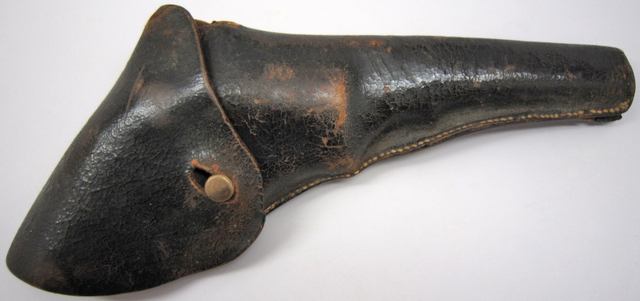
Black leather military issue holster for the above pistol used by Javan B. Irvine during the Civil War.
On April 7, 1866 Irvine was
promoted to Captain, Company A of the 2nd Battalion of the 13th
Infantry.
On September 21, 1866, Companies A and I of the 2nd Battalion
13th Infantry were officially re-designated
Companies A and I of the 22nd Infantry, and Irvine thus became
Commanding Officer of Company A 22nd Infantry,
and one of the 22nd’s very first officers during its
reconstitution in 1866.
Irvine was assigned to command
of Company G 22nd Infantry in December 1866.
In April 1869 he was assigned to command of Company A, a position
he served in until his retirement.
During his twenty-five year
service with the 22nd Infantry, Irvine was stationed at all the
major posts where the 22nd Infantry
was assigned, from the different forts in the Dakotas, to Madison
Barracks in New York, to Jefferson Barracks at New Orleans,
to Wilkes-Barre Pennsylvania, to Fort Griffin in Texas, to Fort
Garland and Fort Lewis in Colorado, to Fort Keogh, Montana,
and finally, to Fort Abraham Lincoln, Dakota Territory, where he
served until retirement.
From October 1876 to May 1877,
and again during October and November 1877
Irvine commanded his Company and the post at Fort Wayne, Detroit,
Michigan.
In addition to commanding
Company A Irvine was assigned to command of the Post at Fort
Griffin, Texas in April 1879.
On May 31,1881, he closed down Fort Griffin, Texas, by leading
the only remaining Army unit there, Company A 22nd Infantry
out of the post to Fort Clark, Texas.
Irvine commanded his Company and
the Post at San Antonio, Texas from January through October 1882.
In October he was with the 22nd Infantry rifle team at the
Department of Texas competition.
He commanded Company A and the post at Fort Garland, Colorado from November 1882 to the end of 1883.
From January through June 1884
in addition to commanding Company A Irvine was Instructor of
Musketry
at Fort Lewis, Colorado. From August through October 1884 he was
on Detached Service at Fort Leavenworth
for the Department rifle competition.
During 1885 he was the Range
Officer for Infantry at Fort Lewis. In May 1886 Irvine was on
Detached Service at
For Bayard, New Mexico as the Range Officer for Infantry of the
Department of Arizona. He rejoined his Company
at Fort Lewis in June 1886 and resumed command of his Company in
addition to resuming his duties as Range Officer
for Infantry at Fort Lewis.
From December 22, 1886 to
January 5, 1887 Irvine was away from his Company on Detached
Service at
McElmo Valley, Colorado investigating reported difficulties with
Ute Indians. He brought Company A to
Fort Keogh, Montana in June 1888 when the 22nd Infantry moved to
that Post. In July of 1888 he was
relieved of his duties as Range Officer.
In late July and early August of
1890 Irvine was on Detached Service at Fort Snelling, Minnesota
for the rifle competition of the Department of the Dakotas. In
December 1890 and January 1891 he commanded
a battalion of the 22nd Infantry in the field during the Pine
Ridge Campaign, the final campaign of the Indian Wars.
During March 1891 he was
assigned to command of the Post at Fort Abraham Lincoln and
served in that position
until his retirement.
On May 19, 1891 Javan B. Irvine retired from the Army with the rank of Major and a disability in the line of duty.

Above: The signature of
Javan B. Irvine on the Post Return of Fort Abraham Lincoln, North
Dakota
for the month of March 1891. Irvine signed the document as a
Captain of the 22nd Infantry Commanding the Post.
|
A formal portrait taken of As with the photo at the top of
this page The Center for Western Studies
- Augustana University Photo from the 1st Minnesota Volunteer Infantry website |
Irvine’s favorite pastime
when not on duty was hunting. Members of the 22nd Infantry formed
a hunting club, and kept dogs
to aid them on their trips into the field, looking for rabbits,
antelope and other game. At first the club used fox hounds,
but replaced them with pure bred English Greyhounds. On November
9, 1872, Irvine set out from Fort Sully, Dakota,
to hunt alone on horseback with the dogs. A few miles from the
fort an Indian rode up to him and said he was trying to find
some ponies which had strayed. Irvine recognized the Indian and
thought him to be friendly. Suddenly the Indian pulled a revolver
which had been concealed, and shot at Irvine four times and then
rode off. Irvine was struck by a bullet which lodged in his
scalp.
He returned to the post, where the Surgeon said the bullet had
glanced off his head and made a lump, dressed the wound,
and sent Irvine to his quarters. Sometime later, convinced the
bullet was still in that lump, Irvine sent for the doctor to come
and take it out. With some difficulty the surgeon began to cut,
and found that, indeed, the bullet was still in Irvine’s
head,
and finally managed to get it out. All together, the bullet had
remained in Irvine’s scalp for some eight hours before being
removed.
That bullet was on display in
2011 at the South Dakota Cultural Heritage Center in Pierre,
South Dakota.
It was part of the "Proving Up" gallery along with
Javan B. Irvine's "ditty bag." Capt. Irvine's grandson,
Lawrence Riggs donated the bullet to the South Dakota State
Historical Society in 1983.
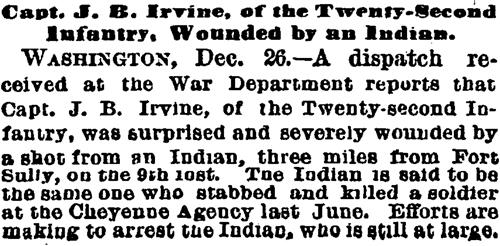
Newspaper clipping describing the shooting of Irvine in 1872.
From Ancestry.com
In May of 1873 Lieutenant
Colonel George Armstrong Custer was moving the Seventh Cavalry
Regiment
to Fort Abraham Lincoln, and camped for several days only a few
miles from Fort Sully. Upon hearing of the Greyhounds
of the 22nd Infantry Hunting Club, Custer proposed a race between
them and his own Greyhounds, of which he was known
to brag about wherever he went. The dogs of the 22nd Infantry
handily beat Custer’s dogs in the race, and Irvine proudly
reported
that "during the straight chase our slowest dog kept ahead
of General Custer's fastest."
|
Left: Dress epaulettes for a Captain
in the 22nd Infantry The regimental number 22 is
applied in gold bullion The black metal storage case is standard issue. These epaulettes were
apparently converted from From the |
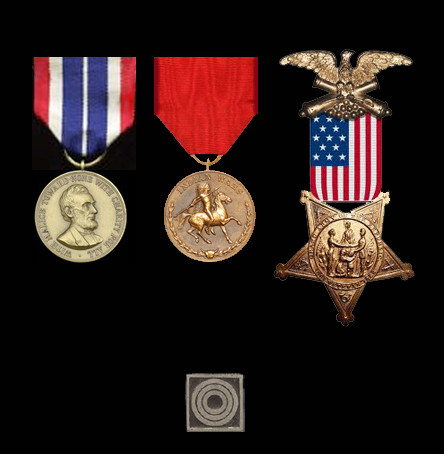
Javan B. Irvine's decorations
Top left to right: Civil
War Campaign Medal, Indian Wars Campaign Medal,
Grand Army of the Republic Medal
Bottom: U.S. Army Marksman Button
At some time during his frontier
service, Irvine met and became friends with the legendary William
F. Cody,
also known as Buffalo Bill. Cody presented Irvine with a coat
made from the skin of a buffalo that Cody had killed.
Upon his retirement, Irvine gave the coat to Second Lieutenant
Albert C. Dalton, of Company A, 22nd Infantry,
preferring that it go to a soldier still on active duty who could
make use of it.
That coat is on display at the Smithsonian National Museum of American History.
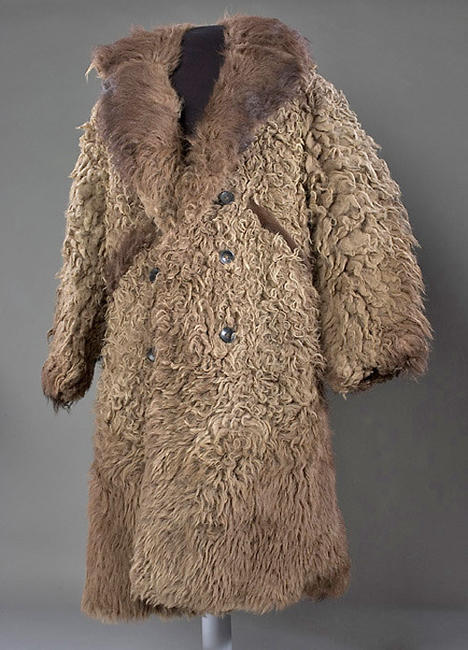
The buffalo coat of
Captain Javan B. Irvine on display at the
Smithsonian National Museum of American History
From Brigadier General
Albert C. Dalton, US Army (Ret'd), written 26th July 1951:
"This coat was made from the skin of a buffalo killed by the
celebrated "Buffalo Bill" (Mr. William F. Cody) at the
time he was engaged in supplying buffalo meat to the workers on
the Union Pacific Railway,
and also to the troops of the United States Army in the same
area. The skin was presented to Captain Javan B. Irvine 22nd US
Infantry who was
a famous Indian fighter and a close friend of Buffalo Bill during
the days when he was with the army as a guide and Indian Scout.
Captain Irvine
presented the coat to then 2nd Lieut Albert C. Dalton 22nd Inf.
who served in Captain Irvine's Company "A" 22nd
Infantry from May 1889
to Aug 1891---when he was commissioned as a 2nd Lieut and
assigned to the regiment for duty as an officer. Captain Irvine
retired the same year
and on leaving the regiment gave the coat to Lieut Dalton. The
coat was repaired and the quilted lining put in in place of the
old lining in 1910
at the Schuykill Army Factory".
Photo from The National Museum of American History website
During retirement Irvine moved to California, where he died on January 20, 1904.
Burial:
Evergreen Cemetery
Los Angeles
Los Angeles County
California
Section H Lot 5076
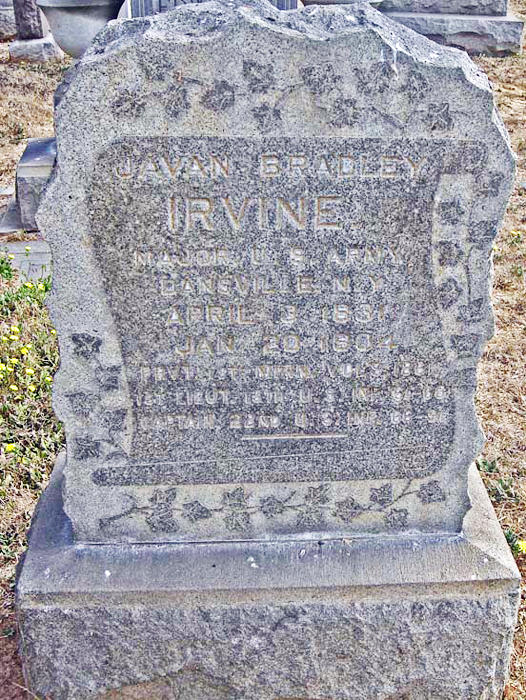
Grave marker for Javan B. Irvine
The inscription reads:
JAVAN BRADLEY
IRVINE
MAJOR U.S. ARMY
DANSVILLE, N.Y.
APRIL 3, 1831
JAN. 20, 1904
PRIVATE MINN. VOLS. 1861
1S LIEUT. 13TH U.S. INF. 61-66
CAPTAIN 22ND U.S. INF. 66-91
Photo by TLS from the Find A Grave website
The Javan Bradley Irvine Papers at the South Dakota State Historical Society
The Javan Bradley Irvine Papers are part of the archives collection of the South Dakota State Historical Society.
The diaries and correspondence
of Javan B. Irvine describe major events and routine activities
in the Dakota Territory in the
1860's and 1870's, particularly along the Missouri River, and
provide a glimpse into the daily life of a career military
officer
and his family. Much of the correspondence is between Irvine and
his wife, Margaret, during their long separations. Also included
is his extensive correspondence with Margaret during his Civil
War service and a variety of other materials related to the
family's history.
¹ THE HISTORY OF MINNESOTA: FROM THE EARLIEST
FRENCH EXPLORATIONS TO THE PRESENT TIME
by Edward Duffield Neill Minnesota Historical Company,
Minneapolis, MN 1882 pp. 672-674
Additional Sources:
Official US Army Registers 1866-1904
Monthly Returns of the 22nd Infantry 1866 - 1891
U.S. Returns from Military Posts 1806-1916
Annual Reports to the Secretary of War 1872
Historical Register and
Dictionary of the United States Army Volume 1
by Francis B. Heitman Government Printing Office, Washington,
D.C. 1903
First Minnesota Volunteer Infantry Regiment website
Vernon Lynch, "FORT GRIFFIN," Handbook
of Texas Online
(http://www.tshaonline.org/handbook/online/articles/uef04),
accessed January 09, 2012. Published by the Texas State
Historical Association.
Home | Photos | Battles & History | Current |
Rosters & Reports | Medal of Honor | Killed
in Action |
Personnel Locator | Commanders | Station
List | Campaigns |
Honors | Insignia & Memorabilia | 4-42
Artillery | Taps |
What's New | Editorial | Links |